Women's Advances in 2023.
How we are according to them.
(we= women in the workplace)
(them=researchers)
The glass ceiling has cracked in many industries, but the broken ladder rung keeps women from equal advancement opportunities. Post-COVID and after the Great Breakup - women in the workplace are feeling less burnout but more concerned about mental health. We don’t feel supported to bring up or ask for mental health support as much as we did during the pandemic. We have made our voices heard in preferring remote and hybrid work but are learning the dangers of such, requiring advocacy for ourselves. We are working off hours more than ever for our jobs and at home. The Barbie movie made a dent in waking up our male and female colleagues, but male sponsorship continues to be weak without widespread organizational commitment to gender equality leadership. We learned of new studies showing again the reality of the pay gap for the same position and education right out of the gate, especially after the first child's birth. Thanks to organizations like ExecuShe, we are learning that not all executive positions can be compared as apples to apples regarding women's equality opportunities. Global gender power gaps have come to light based on shared ownership through certain executive positions. And so much more!
What have you experienced as a woman in the workplace in 2023? As a male leader, what have you done to build a gender equality workplace? 2024 is right around the corner. Together, we can build more successful businesses with happy, engaged, and productive staff members of all stripes and feathers around the table.
Mental Health Concerns Growing
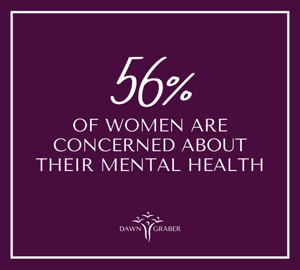 The pendulum has swung away from the concerted effort leaders brought to mental health during the pandemic. The Deloitte 2023 Women at Work study found that 56% of women are concerned about their mental health and out of that number over a third of us rate our mental health as poor or very poor. The real rub is that we are feeling less safe and supported to bring up mental health concerns at work, less than we did during the tough times of COVID. Only 40% of women feel we are getting adequate mental health support at work. This is down from 2022. In fact, women expect a penalty if they bring up mental health concerns at work. Therefore, only 25% of us feel comfortable talking about mental health concerns at work. We need to be mindful of minimizing mental health concerns for our employees. Something has changed for women in the workplace regarding mental health. In 2022, 43% of women felt comfortable talking about mental health, but now only a quarter of us do.
The pendulum has swung away from the concerted effort leaders brought to mental health during the pandemic. The Deloitte 2023 Women at Work study found that 56% of women are concerned about their mental health and out of that number over a third of us rate our mental health as poor or very poor. The real rub is that we are feeling less safe and supported to bring up mental health concerns at work, less than we did during the tough times of COVID. Only 40% of women feel we are getting adequate mental health support at work. This is down from 2022. In fact, women expect a penalty if they bring up mental health concerns at work. Therefore, only 25% of us feel comfortable talking about mental health concerns at work. We need to be mindful of minimizing mental health concerns for our employees. Something has changed for women in the workplace regarding mental health. In 2022, 43% of women felt comfortable talking about mental health, but now only a quarter of us do.
Mental health concerns in 2023 for women were affected by economic worries, wars, the effects of polarization and fear, the threat of gun violence at home (now the number one cause of death for children 1-19 in the US), loneliness and isolation, and the total hours combined of home and work responsibilities.
Cracking the Glass Ceiling
There was much rejoicing when women approached 30% representation in some industries in executive leadership. Yaay! Well done, women and the executives who opened the doors for these qualified leaders! McKinsey’s 2023 report reminded us that in 2015, we could track only 17% of women in senior US executive roles. 2023’s numbers came in at a combined 28% representation of US executive women. We should applaud the 65% change in representation of women at the C-Suite levels from 2015-2023.
 AND with a more significant number of women in the C-suite, we have markers to examine and continue to improve. The danger now is to be silent, feeling as if the game has changed and our work towards equality in leadership senior roles is done. This means even 3 out of 10 senior positions filled by women - although better than it’s been - is not something to write home about. When do we stop improving any assessment that scores at 30%? The danger is celebrating 28% of women’s representation in the US in senior executive positions and not committing in the same breath to keep working until that number is at least 50%. Here are two additional reasons why celebrating 28% representation in senior executive positions isn’t enough:
AND with a more significant number of women in the C-suite, we have markers to examine and continue to improve. The danger now is to be silent, feeling as if the game has changed and our work towards equality in leadership senior roles is done. This means even 3 out of 10 senior positions filled by women - although better than it’s been - is not something to write home about. When do we stop improving any assessment that scores at 30%? The danger is celebrating 28% of women’s representation in the US in senior executive positions and not committing in the same breath to keep working until that number is at least 50%. Here are two additional reasons why celebrating 28% representation in senior executive positions isn’t enough:
1. Women of Color, and specifically Latinas, are not making representational strides.
Women of color continue to experience the most tremendous gender bias, keeping them out of senior roles. Only 6% of women of color are currently in the C-suite, according to McKinsey’s 2023 report. Women of color face the sharpest drop off from their entry-level participatory numbers compared to their executive leadership numbers. As they move up the pipeline, the representation of women of color drops by ⅔’s. And only 1% of Latinas are in C-suite executive positions in the US. I have biracial grandchildren with a Mexican-born father. These abysmal statistics for Latinas in the US need concentrated attention from us all.
2. All C Suite representation of women is not apples to apples.
The two most powerful executive roles are the CEO and Executive Chairperson. Globally, though, these are the least diverse executive roles, with 79% being filled by white men. Power here is defined by share ownership. Power comes from who controls, manages, and owns the business. Gender power gaps are much more strikingly different than even gender representation gaps. The numbers in this section come from ExecuShe. They are doing excellent live gender data analysis of organizations around the world and is an essential live data set I follow closely to understand challenges and opportunities for women in the workplace in the US and worldwide.
ExecuShe shows as of 12-10-23 that women executives make up 28% of the 4274 publicly traded companies, with only 11% of the power based on share ownership. Here are the current representational percentages as of 12-11-23 of women in executive roles in the US currently from Execushe:
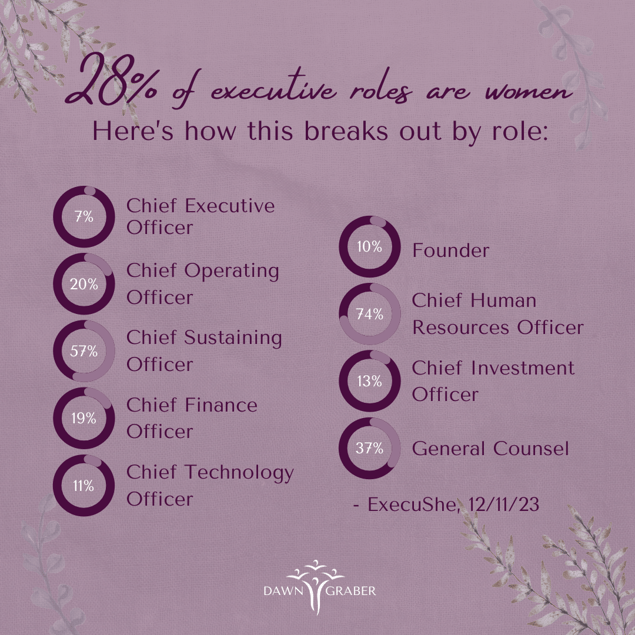
You’ll note that if we count women CEOs as the only executive role counted, we would be celebrating 7%, not 28%, of women’s representation. By tabulating in the 74% of Chief Human Resource Officer roles filled by women (which are part of the total mix), we have earned the hoopla of cracking the glass ceiling. But the Chief Sustainability Officer, General Counsel, and Human Resource Officer numbers of women in these senior roles have blinded us to the reality of the greatest number of women not yet being considered and advancing to the CEO position. We must continue to peel back the layers to understand where women are leading and what power they have in that position to affect change. Building a senior team where women are more than 30% present will bring positive changes from a diverse team. But women are still under 10% in the US for filling senior seats. Do you really believe there is only one qualified woman to 90 other men for the top role? I sure don’t. Why is this continuing? Don’t let this fact of only 7% female CEO representation get masked under the 30% glass ceiling celebration.
Concentrate on the Broken Rung
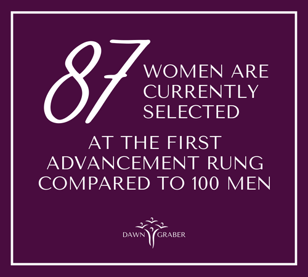 McKinsey’s 2023 Woman in the Workplace showed us that continuing this year and similar to recent years - the broken rung keeps women out of advancement opportunities. What does this mean? Men and women enter the workforce at roughly the same representation. But once the first opportunity for advancement comes, men are selected over women, and the pipeline narrows for women at each opportunity. By the time the selection process takes place for the executive suite roles, fewer women are available for consideration. Only 87 women are currently selected at the first advancement rung compared to 100 men. That is the broken rung that needs to be fixed so that women lead more than 7% of CEOs in publicly traded companies. As mentioned earlier, if you are a woman of color, you are chosen for that first managerial or advancement position 82 times compared to a man's 100 times. If you are a Latina, sadly, only 75 times you are chosen to step over that first rung compared to a man’s 100 times. The broken rung continued for women in 2023 and sorely needs systemic policy revamping involving advancement reviews and selection. What are you doing to ensure a non-biased evaluation and invitation for advancement in the earliest stages of your organization?
McKinsey’s 2023 Woman in the Workplace showed us that continuing this year and similar to recent years - the broken rung keeps women out of advancement opportunities. What does this mean? Men and women enter the workforce at roughly the same representation. But once the first opportunity for advancement comes, men are selected over women, and the pipeline narrows for women at each opportunity. By the time the selection process takes place for the executive suite roles, fewer women are available for consideration. Only 87 women are currently selected at the first advancement rung compared to 100 men. That is the broken rung that needs to be fixed so that women lead more than 7% of CEOs in publicly traded companies. As mentioned earlier, if you are a woman of color, you are chosen for that first managerial or advancement position 82 times compared to a man's 100 times. If you are a Latina, sadly, only 75 times you are chosen to step over that first rung compared to a man’s 100 times. The broken rung continued for women in 2023 and sorely needs systemic policy revamping involving advancement reviews and selection. What are you doing to ensure a non-biased evaluation and invitation for advancement in the earliest stages of your organization?
Remote Work’s Opportunities AND Dangers for Women (extra work)
Women’s burnout has decreased due to the increase in remote and hybrid possibilities, which greatly benefit women. McKinsey’s 2023 Women in the Workplace research shows that over this last year, women through increased remote and hybrid work experienced fewer microaggressions, had a higher level of psychological safety, benefitted from fewer interactions with unpleasant coworkers, and were healthier without appearance or personal style pressure. Indeed, remote and hybrid work has allowed for more flexibility to help organize and participate in child and elder care and decrease pressures that build towards burnout.
 But remote and hybrid work pose dangers for women in the workplace that we must guard against. In 2023, the Deloitte Women at Work study showed that the main drawback of remote and hybrid work was that women had a more challenging time stopping work. 37% of women felt they could switch off work compared to 45% in 2022. We may be less burned out now, but if ⅔’s of us feel we need to answer emails in the evening and continue working on our lap while our kids are doing homework- how long before there’s another Great Resignation? The ability to throw in a load of laundry or unload the dishwasher between Zoom meetings seems like a plus. Still, women are not experiencing equality in the home concerning the division of responsibilities. All these extra work hours take their toll not only on the mental health of women but also on their physical health and rob women of creative downtime that comes from space for recharging. McKinsey’s 2023 report showed that women continue to do the majority of childcare, cleaning, and other domestic tasks. Since COVID, we’ve had the data to show how many more total hours of work women do per week than their male partners. For couples who believe in building an equitable world- why is it so hard to work on our relationships determining who does the dishes, makes the bed, orders groceries, and checks the homework? We can do better.
But remote and hybrid work pose dangers for women in the workplace that we must guard against. In 2023, the Deloitte Women at Work study showed that the main drawback of remote and hybrid work was that women had a more challenging time stopping work. 37% of women felt they could switch off work compared to 45% in 2022. We may be less burned out now, but if ⅔’s of us feel we need to answer emails in the evening and continue working on our lap while our kids are doing homework- how long before there’s another Great Resignation? The ability to throw in a load of laundry or unload the dishwasher between Zoom meetings seems like a plus. Still, women are not experiencing equality in the home concerning the division of responsibilities. All these extra work hours take their toll not only on the mental health of women but also on their physical health and rob women of creative downtime that comes from space for recharging. McKinsey’s 2023 report showed that women continue to do the majority of childcare, cleaning, and other domestic tasks. Since COVID, we’ve had the data to show how many more total hours of work women do per week than their male partners. For couples who believe in building an equitable world- why is it so hard to work on our relationships determining who does the dishes, makes the bed, orders groceries, and checks the homework? We can do better.
Finally, concerning the mixed bag of remote work for women - working off-site magnifies the loss of informal influence women routinely miss out on, especially when the senior executive is male. Women continue to feel excluded from meetings, decision-making, and informal invitations like the golf game, drinks after work, or banter over lunch at the neighborhood restaurant. If you’re working remotely or supervising remote workers- make sure their access to you is as open as those who work down the hall. You must plan to make this happen, or the default will harm your remote workers.
2023 was a Good Year for Women’s Representation
But we lack the power of ownership and are not in the highest seats of influence from which we are also capable of leading. The ceiling is cracked, but not overall in the CEO position. Our representation in executive senior teams makes a positive difference, reaching over 30% more routinely now. Our mental health will soon begin suffering more if our places of employment don’t hurry up and again invite mental health concerns to be shared and offer meaningful support. We continue working longer than our male partners with home and dependent care responsibilities. We appreciate the flexibility of remote work but are missing out on being included in meaningful relationships and decisions. We need systemic revamping of advancement practices primarily at the first rung of opportunity so the pipeline is more full of qualified women to be considered for senior positions.
2023 was a good year for women’s representation.
But 2024 can be better.
Let’s build a more equal and equitable gendered work culture for the betterment of all. I’d love to help you explore how that can look at your organization.
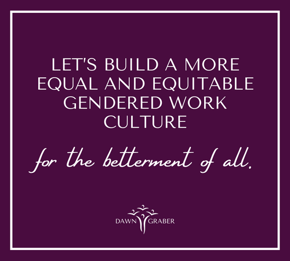
Transforming influence alongside you,

What I’m Reading:
- Deloitte Women @ Work 2023 Report
- McKinsey Women in the Workplace 2023
- ExecuShe 2023 live data website with subscription
- Our Epidemic of Loneliness and Isolation from the U.S. Surgeon General’s Advisory on the Healing Effects of Social Connection and Community 2023.
- CDC on gun violence as the leading cause of death for US children

December 14, 2023
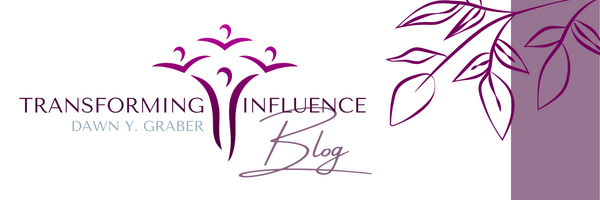
Comments